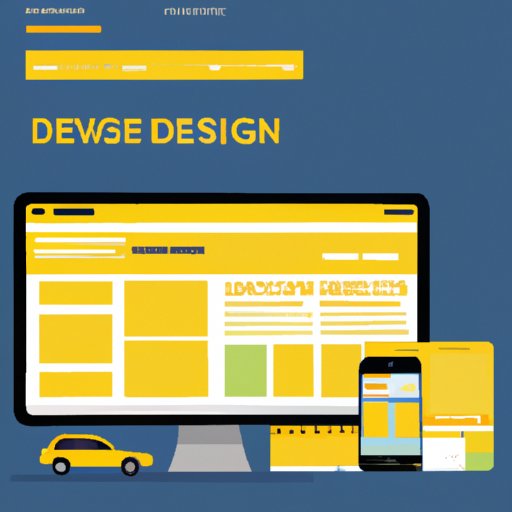
I. Introduction
As the world continues to evolve with technology, having a website for your business is no longer an option but a necessity. A website is your online presence and acts as a portal to reach a wider audience. A professional website is crucial for customers to find information about your business, connect with you, and even buy your products or services. In this article, we will explore how to make a website for a business that is professional, visually appealing, and profitable.
II. A Step-by-Step Guide to Building a Business Website
Before building a website, it is important to plan and prepare. Consider your target audience, the website’s purpose, and your business goals. With these factors in mind, follow these six steps:
1. Choose a Domain Name and Hosting Provider
A domain name is the address people use to find your website and should represent your business. Choose a name that is easy to remember and simple to spell. Next, choose a hosting provider, which is where your website’s files will be stored. Consider factors such as speed, uptime, customer support, and pricing when selecting a provider.
2. Select a Website Platform
Website platforms are used to create the website and vary in features, ease of use, pricing, and scalability. WordPress, Squarespace, Wix, and Shopify are popular options. Consider your website’s purpose, features needed, and your budget when choosing a platform.
3. Design the Website
Your website’s design should be professional, visually appealing, and consistent with your brand. Elements such as color, typography, and imagery are crucial in creating a cohesive design. Use templates and tools provided by your platform or hire a professional designer to create a unique design.
4. Add Content and Functionality
Your website’s content should be clear, concise, and provide value to visitors. Include relevant information such as contact information, services, products, and blog content. Add functionality such as social media links, contact forms, and e-commerce capabilities.
5. Launch the Website
Before launching, thoroughly test the website for functionality, usability, and compatibility. Once ready, launch the website and promote it to build traffic and generate revenue.
III. How to Choose the Right Website Platform for Your Business
Choosing the right website platform is crucial to creating a website that is both functional and easy to use. Consider the following when selecting a platform:
1. Platform Features
Different platforms have varying features, such as blogging capabilities, e-commerce capabilities, and SEO optimization. Consider your website’s purpose and goals when selecting a platform with features that accommodate them.
2. Ease of Use
Website platforms vary in ease of use, from beginner-friendly to more complex options. Consider your technical ability, time, and resources when selecting a platform that suits your needs.
3. Pricing
Pricing varies among website platforms, with some offering free plans and others with monthly fees. Consider the platform’s pricing versus your budget when selecting a platform.
4. Scalability
Consider a platform’s scalability as your business grows and your website’s needs change. Ensure the platform can accommodate your changing needs without compromising website functionality.
IV. Creating a Business Website That Stands Out
A visually appealing website design is crucial in standing out and attracting customers. Consider the following design elements:
1. Color
Color evokes emotions and can influence customer behavior. Choose colors consistent with your brand and message.
2. Typography
Typography is the text on your website and can impact user experience and readability. Choose fonts that are clean, legible, and consistent.
3. Imagery
Visual elements such as images and videos can convey your message and evoke emotions. Choose images consistent with your brand and message.
V. How to Drive Traffic to Your Business Website
Website traffic is crucial in generating revenue and attracting customers. Consider the following strategies to drive traffic to your website:
1. SEO Optimization
Search engine optimization (SEO) is the process of optimizing your website to rank higher in search engine results. Consider keywords, meta tags, and backlinks to optimize your website.
2. Social Media Marketing
Social media is a platform to promote your website and reach a wider audience. Consider engaging with followers, using hashtags, and paid advertising to promote your website.
3. Email Marketing
Email marketing is a form of direct marketing that involves sending promotional emails to subscribers. Consider building an email list and creating engaging content to drive traffic and revenue from your website.
VI. Building a Mobile-Friendly Website for Your Business
Mobile devices account for over half of all internet traffic, making a mobile-friendly website crucial in reaching a wider audience. Consider the following best practices for mobile optimization:
1. Responsive Design
Responsive design allows your website to adjust to different screen sizes, making it easily accessible on any device.
2. Page Speed Optimization
Page speed optimization involves optimizing website elements to load quickly, improving the user experience and search engine rankings.
3. Mobile-Friendly Content
Mobile content should be clear, concise, and easy to navigate on smaller screens.
VII. Conclusion
Creating a website for your business is necessary in today’s world, and with this step-by-step guide, you will be able to create a professional, visually appealing, and profitable website. Consider the website planning process, website platforms, design elements, traffic generation, and mobile optimization to create a website that achieves your business goals. With a functional and visually appealing website, you can stand out from your competitors, drive traffic, and increase revenue.





